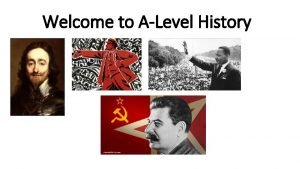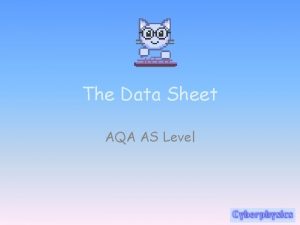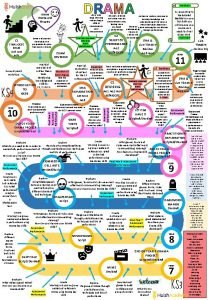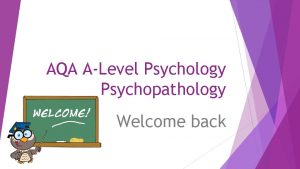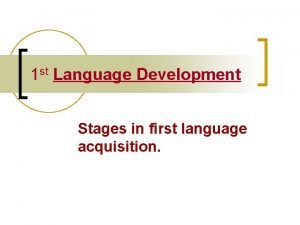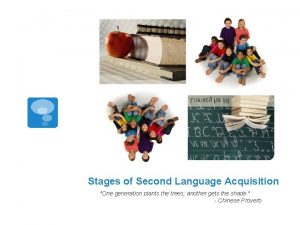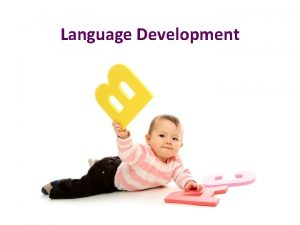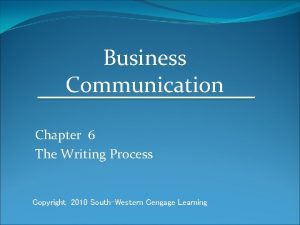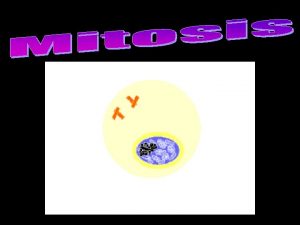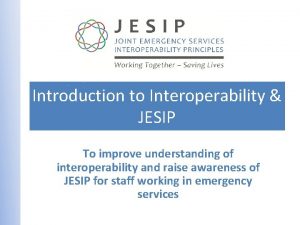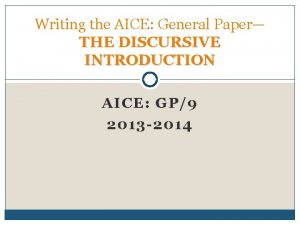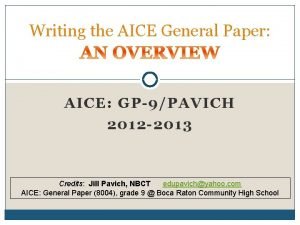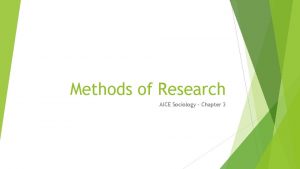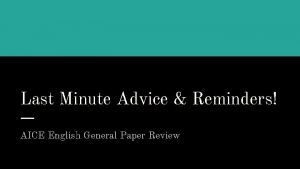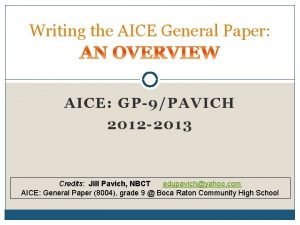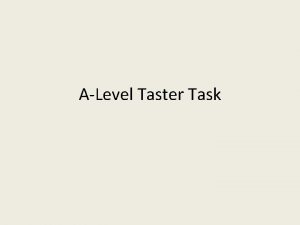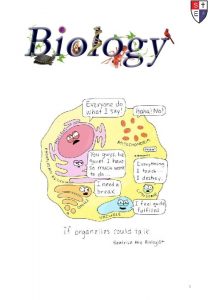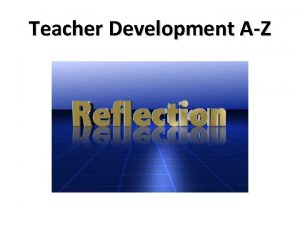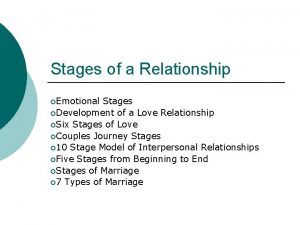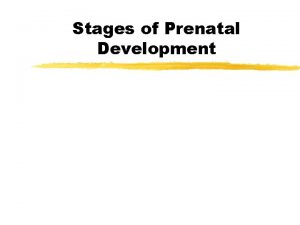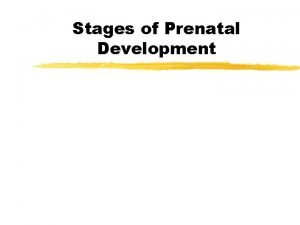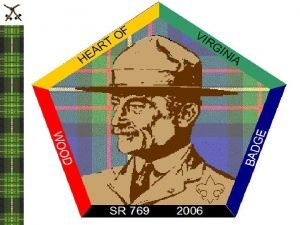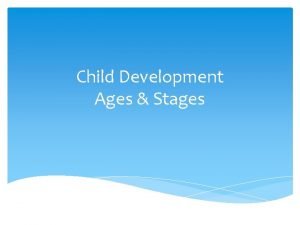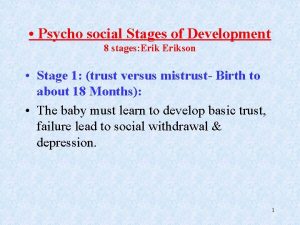Main Stages of Language Development AICE ALevel Language
















- Slides: 16

{ Main Stages of Language Development AICE A-Level Language

Milestones In spite of different backgrounds, different locations, and different upbringings, most children follow the very same milestones in acquiring language. https: //www. youtube. com/ watch? v=v. Q 64 R 0 KKssc

Critical Periods What is a critical period? For first language acquisition, there seems to be a critical period of the first five years, during which children must be exposed to rich input. There is also a period, from about 10 -16 years, when acquisition is possible, but not native-like.

Stages of Learning Sound production/babbling Phonological acquisition Morphological/Syntactical acquisition Semantic development

Caretaker Speech A register characterized by: Simplified lexicon Phonological reduction Higher pitch Stressed intonation Simple sentences High number of interrogatives (Mom) & imperatives (Dad)

Caretaker Features signing on the baby's body (when the location should be on the signer) ¾ using the baby's hands to sign on the adult's or child's body ¾ placing the child on the lap and facing away from the mother ¾ signing on the object ¾ signing using the object ¾ signing bigger than normal ¾ signing repeated more often then normal ¾ sign lasts longer than normal ¾ signing special “baby” signs rather than adult signs ¾

Linguistic Stages 6 -12 weeks: Cooing (googoo, gurgling, coocoo) 6 months: Babbling (baba, mama, dada) 8 -9 months: Intonation patterns 1 -1. 5 years: Holophrastic stage (one word) 2 years: Two-word stage 2. 5 years: Telegraphic stage 3, 4 – 11 years: Fluent speech w/errors 12 years+: Fluent speech

Holophrastic Stage This stage is characterized by one word sentences Nouns make up around 50% of the infants vocabulary while verbs and modifiers make up around 30% and questions and negatives make up the rest. Infants use these sentence primarily to obtain things they want or need https: //www. youtube. com/watch? v=_ NZMJBMUHU 8

Telegraphic Stage This stage contains many three and four word sentences Sometime during this stage the child begins to see the links between words and objects and therefore overgeneralization comes in During this stage a child’s vocabulary expands from 50 words to up to 13, 000 words

Acquisition of Phonetics Few weeks: cooing and gurgling, playing with sounds. Their abilities are constrained by physiological limitations. 4 months: distinguish between [a] and [i], so their perception skills are good. 4 -6 months: children babble, putting together vowels and consonants. This is not a conscious process! Experiment with articulation 7 -10 months: starts repeated babbling. 10 -12 months, children produce a variety of speech sounds. (even ‘foreign’ sounds)

Acquisition of Phonology Early stage: Unanalyzed syllables 15 -21 months: words as a sequence of phonemes. Mastery of sounds differing in distinctive features (e. g. , voicing) Duplicated syllables: mama, dada - CV is main syllable structure. They reduce = banana [na. na] 2 syllable words Early mastery of intonation contours (even in non -tone languages) Perception comes before production (‘fis’ or ‘fish’? )

Lexicon Begin with simple lexical items for people/food/toys/animals/body functions Lexical Achievement: 1 -2 years old 3 years old 4 years old 5 years old 6 -7 years old High school grad 200 -300 words (avg) 900 words 1500 words 2100 words 2500 words 40, 000 – 60, 000 words! “ 5, 000 per year, 13 words a day” -- Miller & Gildea

Negative Formations 1 stage - attach no/not to beginning of sentence (sometimes at end) 2 nd stage – negatives appear between subject and verb 3 rd stage – appearance of nobody/nothing & anybody/anything & inconsistent use of “to be” verb is st

Question Formations 1 st stage – wh- word placed in front of rest of sentence: Where daddy go? 2 nd stage – addition of an auxiliary verb: Where you will go? 3 rd stage – subject noun changes places with the auxiliary: Where will you go?

Acquisition of Semantics Concrete before abstract: ‘in/on’ before ‘behind/in front’ Over-extensions: Using ‘moon’ for anything round Using ‘dog’ for any four-legged animals Under-extensions: The word ‘bird’ may not include ‘pigeon’, etc.

 Edexcel alevel history
Edexcel alevel history Aqa alevel data sheet
Aqa alevel data sheet Drama alevel
Drama alevel Saira has a fear of cats
Saira has a fear of cats June 2021 english language paper 1
June 2021 english language paper 1 Theory of language development by chomsky
Theory of language development by chomsky Speech emergence stage activities
Speech emergence stage activities Three word stage
Three word stage What is writing process in business communication
What is writing process in business communication Four main stages of the cell cycle
Four main stages of the cell cycle 4 main stages of a major incident jesip
4 main stages of a major incident jesip Discursive introduction example
Discursive introduction example Aice general paper rubric
Aice general paper rubric Miami senior high school transcript request
Miami senior high school transcript request Paper 2 aice general paper
Paper 2 aice general paper Aice sociology
Aice sociology Aice general paper final exam
Aice general paper final exam
